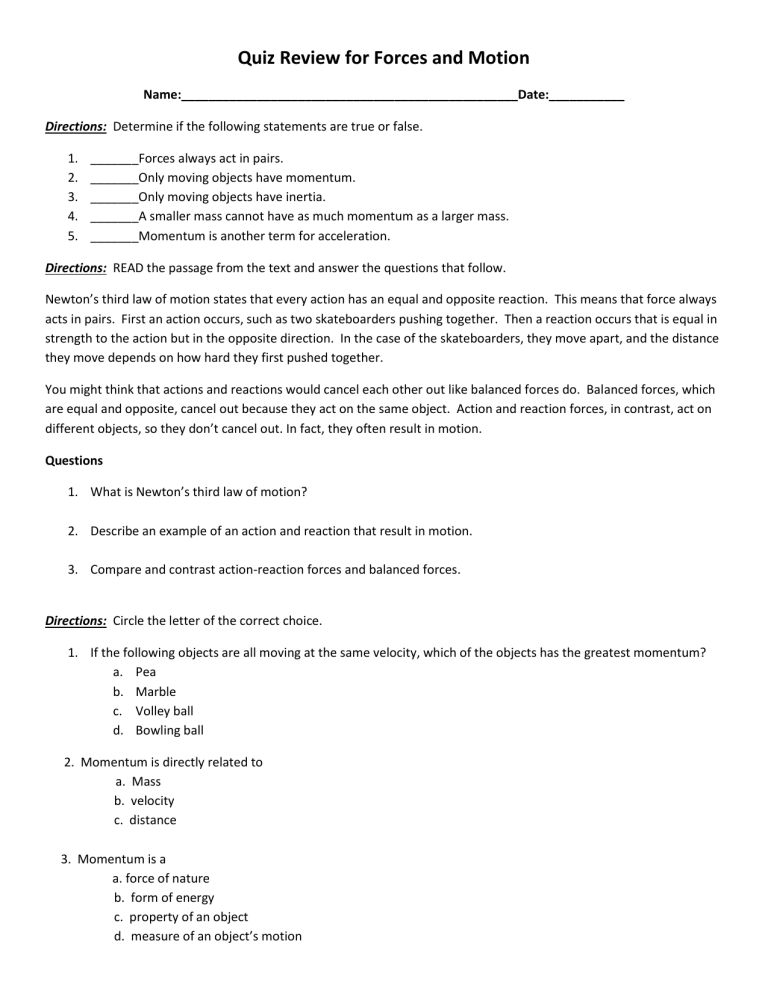
Quiz Review for Forces and Motion Name:_________________________________________________Date:___________ Directions: Determine if the following statements are true or false. 1. 2. 3. 4. 5. _______Forces always act in pairs. _______Only moving objects have momentum. _______Only moving objects have inertia. _______A smaller mass cannot have as much momentum as a larger mass. _______Momentum is another term for acceleration. Directions: READ the passage from the text and answer the questions that follow. Newton’s third law of motion states that every action has an equal and opposite reaction. This means that force always acts in pairs. First an action occurs, such as two skateboarders pushing together. Then a reaction occurs that is equal in strength to the action but in the opposite direction. In the case of the skateboarders, they move apart, and the distance they move depends on how hard they first pushed together. You might think that actions and reactions would cancel each other out like balanced forces do. Balanced forces, which are equal and opposite, cancel out because they act on the same object. Action and reaction forces, in contrast, act on different objects, so they don’t cancel out. In fact, they often result in motion. Questions 1. What is Newton’s third law of motion? 2. Describe an example of an action and reaction that result in motion. 3. Compare and contrast action-reaction forces and balanced forces. Directions: Circle the letter of the correct choice. 1. If the following objects are all moving at the same velocity, which of the objects has the greatest momentum? a. Pea b. Marble c. Volley ball d. Bowling ball 2. Momentum is directly related to a. Mass b. velocity c. distance 3. Momentum is a a. force of nature b. form of energy c. property of an object d. measure of an object’s motion Directions: Match each definition with the correct term. Definitions _________1. How to calculate momentum _________2. Unit for momentum _________3. Equal and opposite forces that act on different objects _________4. Combined momentum of objects remains the same when an action-reaction occurs _________5. Property of a moving object that makes it hard to stop _________6. Equal and opposite forces that act on the same object _________7. Every action has an equal and opposite reaction Terms a. momentum b. Newton’s third law of motion c. balanced forces d. kg ∙ m/s e. law of conservation of momentum f. action-reaction forces g. mass x velocity Directions: Fill in the blank with the appropriate answer. 1. What is inertia? 2. Describe how mass and inertia are related. Directions: Fill in the blank with the correct answer. 1. A 20-kg object moving at a velocity of 3m/s has a momentum of__________. Show your work here, be sure to include the proper units. 2. The momentum of a 9-kg object that has a velocity of 3 m/s is___________. Show your work here, be sure to include the proper units. 3. The acceleration due to gravity on Earth is _____________. 4. The three formulas which describe the relationship between mass, force and acceleration are ___________________________, ____________________________, _________________________ Directions: Solve the problems below. Show your work for FULL CREDIT! 1. A force of 52 N acts upon a 4 kg block sitting on the ground. Calcuate the acceleration of the object. 2. An object has a mass of 10 kg and is accelerate upward at 2 m/s2. What force is required? 3. What is the mass of an object if a force of 17 N causes it to accelerate at 1.5 m/s2. 4. How much weight is generated by an 80 kg person on planet earth? 5. What is the mass of a falling rock in the Grand Canyon if it produces a force of 147 N? 6. What is the weight of a 35 kg rock on the moon if the gravity on the moon is 1.62 m/s2. Directions: Fill in the term for the definition on the space provided. 1. The upward force on an object falling through the air is ____________________. 2. The size of the gravitational force that’s applied to it, the greater its _____________will be. 3. Forces that are equal in size but opposite in direction are ___________________forces. 4. The force you need to overcome to start an object moving is ___________________friction. 5. Inertia varies depending on _____________________. 6. You are riding in a car and your friend thinks it’s funny to “brake check” you and your slings forward. This is an example of __________________. Directions: Answer the questions in the space provided using the PDF that is located on our Google Classroom. 1. What is the force that opposes the movement of an object? 2. What causes friction between fluids? What causes friction between solids? Fluids: Solids: 3. What would happen if there is no friction? 4. List the four types of friction and provide an example of each below. A.___________________friction – example:_________________________________ B.___________________friction – example: _________________________________ C. __________________friction – example: _________________________________ D. _________________friction – example:__________________________________ 5. How can friction be lessened? 6. How is friction considered undesirable for machines?




